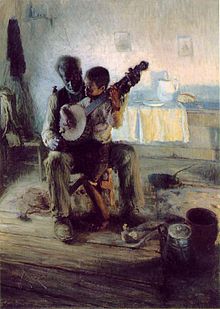
1. Rhythm bones are one of the oldest African instruments and are used as an element of percussion.
2. The djembe drum is a staple instrument for African folk music. It has 3 sounds: bass, tome, slap.
3. Djembe drums are usually played with one player who does a main rhythm and another player who does a background/repetitive pattern.
4. Djembe drums are played at times where people come together such as parties, weddings, and other celebrations.
5. The washboard became an instrument when enslaved Africans (who used it as a tool for chores at first) repurposed it to relieve the negativity of work.
6. Washboards are played with rhythmic hand strokes along the ridges of the board.
7. The banjo is a stringed instrument commonly played in African folk music. It was originally crafted in Africa, where it was called “banjar”.
8. Banjos were appropriated by white people to be used in the production of “country” music and used in minstrel shows.
9. Minstrel shows were a form of theatrical entertainment in which white people would perform comedic skits and dances while in blackface.
10. Minstrel shows were used to mock African Americans by attributing negative stereotypes to them through comedy.
11. The story/song of hambone comes from the passing around of a ham bone among the slave shacks given to them by their masters (the bone came from the leftovers of the master’s dinner).
12. Patting juba/hambone is an African American style of dance involving stomping and slapping/patting the body (mainly the arms, legs, chest, and cheeks) created by enslaved Africans.
12. Step is a present day style of dance that most likely was derived from patting juba/hamboning.
14. Field holler/work songs were created and sun by enslaved Africans to lift their spirits while working.
15. A popular example of field holler is “Wade in the Water”.
16. Work songs were used to spread hidden messages and biblical/cultural parables.
17. Work songs established a rhythm that kept them in sync and helped them work more efficiently.
18. A popular folk singer of the 20th century is Odetta, also known as the “voice of the civil rights movement”.
19. When being transported, enslaved Africans were forced to perform folk music for their masters with singing instruments like the banjo and djembe drum.
20. Djembe drums are mostly played in Guinea, Burkina Faso, Mali, and the Ivory Coast.

